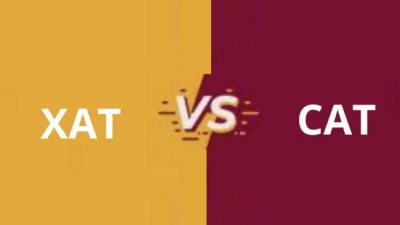While both the CAT and the XAT are entrance exams for some of India's premier business schools, they differ in several ways. Let us understand the key differences between them, starting with the eligibility criteria.
 Eligibility Criteria:
Eligibility Criteria: An applicant must have a graduation grade point average of at least 50% to be eligible to take the CAT exam. There are no percentage-based limits in XAT. All required of an aspirant is that he or she be a graduate or in the final year of graduation. They can apply for the XAT exam if they complete their graduation before June of the year in which the exam is held.
Exam Pattern: The CAT paper is divided into three sections: Verbal Ability, Logical Reasoning, Data Interpretation, Quantitative Aptitude. XAT has three sections as well, although they are distinct: Verbal Ability, Decision Making, Quantitative Aptitude.
In the XAT exam, there is an additional section/part for General Knowledge. The CAT consists of 100 questions divided into three sections: 34, 32, and 34. Approximately 75 questions make up the XAT, with no fixed or apparent allocation. Decision Making, on the other hand, frequently has the fewest questions, with 20-22. There are usually 25 questions in the General Knowledge section.
Time Duration: The CAT exam has typically lasted 180 minutes, but due to the COVID-19 pandemic, the time has been decreased to 120 minutes for CAT 2020. For CAT 2021, the examination authority is scheduled to return to a 180-minute duration.
Let us understand the CAT considering it a three-hour exam with one hour allocated to each section. You cannot utilize the remaining 10 minutes for another sector if you finish a portion in 50 minutes. If you require additional time for a section, you will be unable to do so, and the section will auto-submit once the specified time has expired.
XAT is likewise a three-hour exam, but you can use the time any way you choose. Any part can be used as a starting point. Any question can be attempted in any order. You can jump between portions as many times as you want. You are free to approach the paper in whatever way you see fit.
DI & LR: The trickiest part of the CAT exam is logical reasoning and data interpretation. However, tough is a relative concept. It is usually in the midst of the CAT exam and has eight sets to solve. Four are based on logical reasoning, and four are based on data interpretation.
LR-DI, on the other hand, is not given as much weight by XAT. Data Interpretation problems are occasionally asked in the Quantitative Aptitude portion. Logical Reasoning questions are sometimes asked in conjunction with the Verbal Ability or Decision-Making sections. However, in any of these circumstances, the total number of questions based on LR-DI rarely exceeds ten. In the XAT exam, the weightage for LR-DI is close to 10%.
Decision Making and General Knowledge: The XAT exam has a portion called Decision Making that is unique to it. No other MBA entrance exam, including the CAT, assesses students' decision-making abilities. This includes questions based on real-life scenarios, with students' replies recorded depending on how they act in those circumstances.
There are no questions on General Knowledge in the CAT. The XAT comprises 25 General Knowledge questions covering themes such as general knowledge, current events, business history, and other related articles. The candidate's final XAT percentile does not include these marks. Only XLRI uses these as a criterion for evaluation.
Type of Questions and Negative Marking: CAT majorly has objective questions with a few types in the answer (TITA) type questions. However, only objective questions are asked on the XAT.
If you mark an incorrect option for an objective-type question in the CAT, you will receive a negative mark. You can obtain a negative mark in XAT by doing the following: Firstly, for an objective type of question, you select the incorrect alternative, and secondly, you don't attempt a question.
However, negative marking for the unanswered question is not a standard feature of the XAT exam. Even if it is included, the negative mark assigned to a not attempted question is highly minimal. As an example, there is no negative marking for the first ten questions that were not attempted. A total of one mark would be deducted for the following 20 unanswered questions. It does not have much of an effect, but it surely helps in increasing a candidate's nervousness.
Calculator: Perhaps there is not much of a difference with this one. The fact that applicants will be able to use a calculator throughout the exam may provide some psychological benefit to some candidates. Still, it will hardly make a difference in the end. A rudimentary on-screen calculator is available in CAT but not in XAT.



